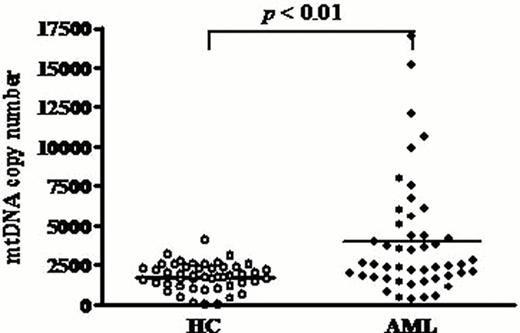Abstract
Abstract 1423
Alteration of mitochondrial DNA (mtDNA) is now implicated in tumorigenesis as well as poor clinical outcomes. mtDNA copy number is altered in patients with various hematological malignancies such as lymphocytic leukemia, lymphoma and other disorders. Moreover, recent studies has reported that mtDNA copy number is associated with increased risk of non-hodgkin lymphoma (Blood 2008;112:4247–9). Therefore, the present study was fist to validate the hypothesis that alteration of mtDNA copy number in bone marrow cell would be associated with risk of childhood acute myeloid leukemia (AML).
Direct sequencing of mtDNA control region, analysis of mtDNA minisatellites and mtDNA copy number were performed in 48 patients with initially diagnosed childhood AML cases and 48 matched case controls from Environmental Health Center for Childhood Leukemia and Cancer cohort. Molecular analysis of mtDNA including quantitation of mtDNA copy number was determined using our published protocol (Int J Cancer 2012;131:1332–41).
Numerous sequence alterations of mtDNA were only found in patient's bone marrow cells. Instability of mtDNA minisatellites was mainly occurred in the 303 polyC and 16184 polyC minisatellite. mtDNA copy number was significantly elevated in patients with childhood AML compared with those of control group (p=0.000075, Fig. 1). There was a dose-response relationship between tertiles of mtDNA copy number and risk of childhood AML (odds ratio [OR], 95% confidence interval [CI]: 1.0; 1.145 [0.412–3.183]; and 6.818 [2.244–20.712], respectively; p(trend) =.000). The effect was most pronounced for childhood AML harboring normal karyotype (OR: 1.0; 1.75[0.369–8.302]; 9.00 [1.888–42.904]; p(trend) =.008) (Table 1).
mtDNA minisatellite inability was frequently observed in bone marrow cells of childhood AML. Elevation of mtDNA copy number could be associated with increased risk of childhood AML, particularly normal karyotype childhood AML.
Increased mtDNA copy number in bone marrow cells of childhood AML. mtDNA copy number from 48 patients with initially diagnosed childhood AML was significantly elevated compared with those from 48 matched healthy controls (HC).
Increased mtDNA copy number in bone marrow cells of childhood AML. mtDNA copy number from 48 patients with initially diagnosed childhood AML was significantly elevated compared with those from 48 matched healthy controls (HC).
Odd ratio (OR) and 95% confidence interval for mtDNA copy number and childhood AML

No relevant conflicts of interest to declare.
Author notes
Asterisk with author names denotes non-ASH members.


This feature is available to Subscribers Only
Sign In or Create an Account Close Modal